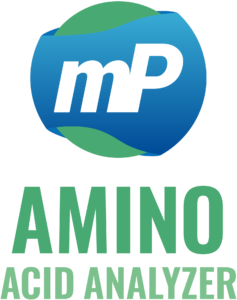Method for the determination of added gelatin in ham and cream cheese using the Amino Acid Analyzer ARACUS
The globalisation of international commerce which also affects the food industry reliable and repeatable methods of chemical analysis have become essential for consumer protection. Ham and crème cheese products is still being pumped up secretly with water and gelatin to increase its size and weight. Gelatin binds the water in the products.
Food fraud, such as the undeclared addition of water and gelatin, not only deceives consumers but also violates food labeling regulations and can undermine trust in food markets (Everstine et al., 2013).
It is a fraud, that the proceeding industry make a profit of millions Euro with added water.
The deliberate addition of protein hydrolysates like gelatin to increase product weight is one of the most common forms of economically motivated adulteration in the meat and dairy sectors (Spink & Moyer, 2011).
Sample preparation and analysis
For each of ham and cream cheese, three articles were purchased and analysed from standard supermarket suppliers.
5 g of the sample were weighed into a plastic cup and mixed with 30 mL ultrapure water and 5 mL internal standard (norleucine 10 µmol/mL). The sample was then homogenized with a commercial blender in intervals of 30 seconds. After addition of 10 mL sulfosalicylic acid (10 % w/w) the sample was incubated for 20 min at 4 °C and then filtered through a micro filter.
Acidic hydrolysis with microwave system: 0.5 mL of the filtrate was mixed with 7.5 mL of hydrochloric acid (6 N) in a vessel body. the hydrolysis was performed at 150° for 15 minutes, cooled down to room temperature and the solution was evaporated on a hot block. The residue was dissolved with 1 mL Sample Dilution Buffer.
The supernatant was filtered with a membraSpin (0.22 µm) by centrifugation at 14000 rpm for five minutes. The particle free solution was used for the injection.
The samples were analyzed by the Amino Acid Analyzer ARACUS, manufactured and distributed by membraPure GmbH worldwide. ARACUS is using the classic routine analysis of amino acids by post-column derivatization with ninhydrin and the detection at 440 nm and 570 nm.
Post-column ninhydrin derivatization remains a gold standard method for the quantitative determination of amino acids, ensuring high sensitivity and specificity even in complex food matrices (Cohen & Michaud, 1993).
Results & Discussion
Table 1 shows the results of the concentration of amino acids in three different samples of cream cheese and Table 2 of three different samples in ham.
Table 1: Amino acid concentration of hydrolyzed NPN (non-protein-nitrogen) in sample 1, 2 and 3 of cream cheese (mg/100 g).
| Amino Acid | 1 | 2 | 3 |
| Asp | 60.8 | 101.8 | 12.9 |
| Thr | 34.3 | 8.6 | 10.1 |
| Ser | 41.5 | 12.0 | 8.5 |
| Glu | 160.4 | 14.1 | 33.2 |
| Gly | 66.7 | 4.4 | 3.2 |
| Ala | 44.6 | 6.2 | 6.9 |
| Val | 35.3 | 5.9 | 6.8 |
| Met | 13.8 | 3.7 | 3.3 |
| Ile | 27.9 | 5.9 | 7.3 |
| Leu | 54.2 | 7.5 | 3.3 |
| Tyr | 14.8 | 4.3 | 3.5 |
| Phe | 19.8 | 3.5 | 2.6 |
| His | 18.6 | 3.9 | 3.3 |
| Lys | 51.9 | 9.5 | 8.8 |
| Arg | 35.2 | 2.9 | 1.8 |
| Pro | 92.5 | 17.9 | 19.8 |
| Hypro | 25.5 | 6.4 | 3.4 |
| Hylys | 2.7 | n.n. | n.n. |
Table 2: Amino acid concentration of hydrolyzed NPN (non-protein-nitrogen) in sample 1, 2 and 3 of ham (mg/100 g).
| Amino Acid | 1 | 2 | 3 |
| Asp | 74.6 | 13.2 | 15.8 |
| Thr | 52.4 | 15.1 | 11.6 |
| Ser | 46.3 | 17.2 | 16.3 |
| Glu | 132.1 | 79.1 | 60.9 |
| Gly | 141.3 | 43.3 | 25.1 |
| Ala | 94.8 | 42.7 | 31.8 |
| Val | 56.2 | 14.0 | 11.2 |
| Met | 21.3 | 3.2 | 6.1 |
| Ile | 37.9 | 7.8 | 8.0 |
| Leu | 61.5 | 17.2 | 15.6 |
| Tyr | 32,7 | 8.9 | 9.7 |
| Phe | 28.6 | 9.7 | 9.2 |
| His | 306.1 | 312.2 | 296.4 |
| Lys | 107.4 | 26.8 | 21.0 |
| Arg | 76.8 | 17.9 | 12.6 |
| Pro | 83.7 | 25.9 | 16.4 |
| Hypro | 34.3 | 13.5 | 12.9 |
| Hylys | 5.9 | n.n. | n.n. |
For both type of samples the amino acid concentrations are increased in sample 1 in comparison with sample 2 and 3.
An addition of animal protein hydrolysate (gelatin) increases the amino acid concentrations of hydrolyzed NPN (non-protein-nitrogen). Especially the levels of hydroxyproline and hydroxylysine. They are markers for added gelatin in crème cheese and ham. When using gelatin a declaration in the list of ingredients is mandatory.
Hydroxyproline is widely regarded as a reliable marker for collagen or gelatin addition, as it is not typically abundant in unprocessed muscle or dairy products (Bobe et al., 2013).
References:
- Everstine K, Spink J, Kennedy S. “Economically motivated adulteration (EMA) of food: common characteristics of EMA incidents.” J Food Prot. 2013;76(4):723-735.
- Spink J, Moyer DC. “Defining the public health threat of food fraud.” J Food Sci. 2011;76(9):R157-R163.
- Cohen SA, Michaud DP. “Synthesis of a fluorescent derivatizing reagent, 6-aminoquinolyl-N-hydroxysuccinimidyl carbamate, and its application for the analysis of hydrolysate amino acids via high-performance liquid chromatography.” Anal Biochem. 1993;211(2):279-287.
- Bobe G, et al. “Hydroxyproline as a marker for meat collagen and gelatin content in processed meat products.” Meat Sci. 2013;95(3):419-423.

